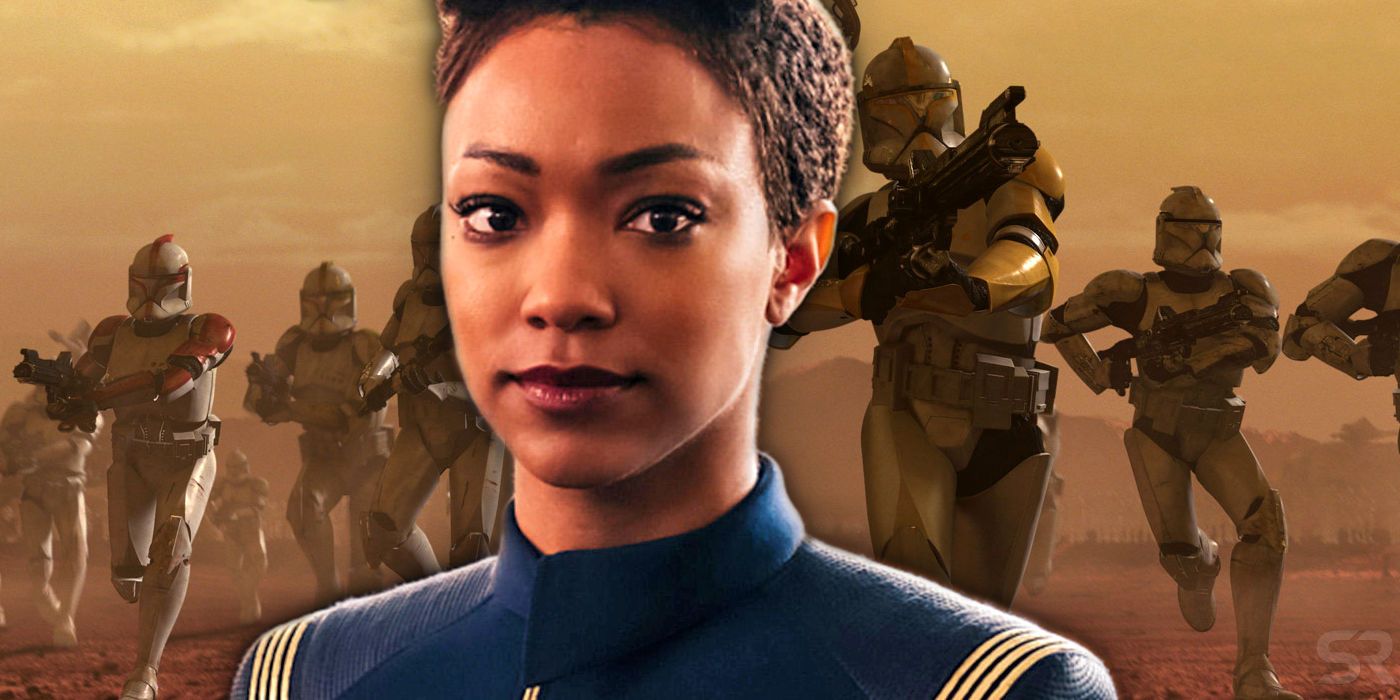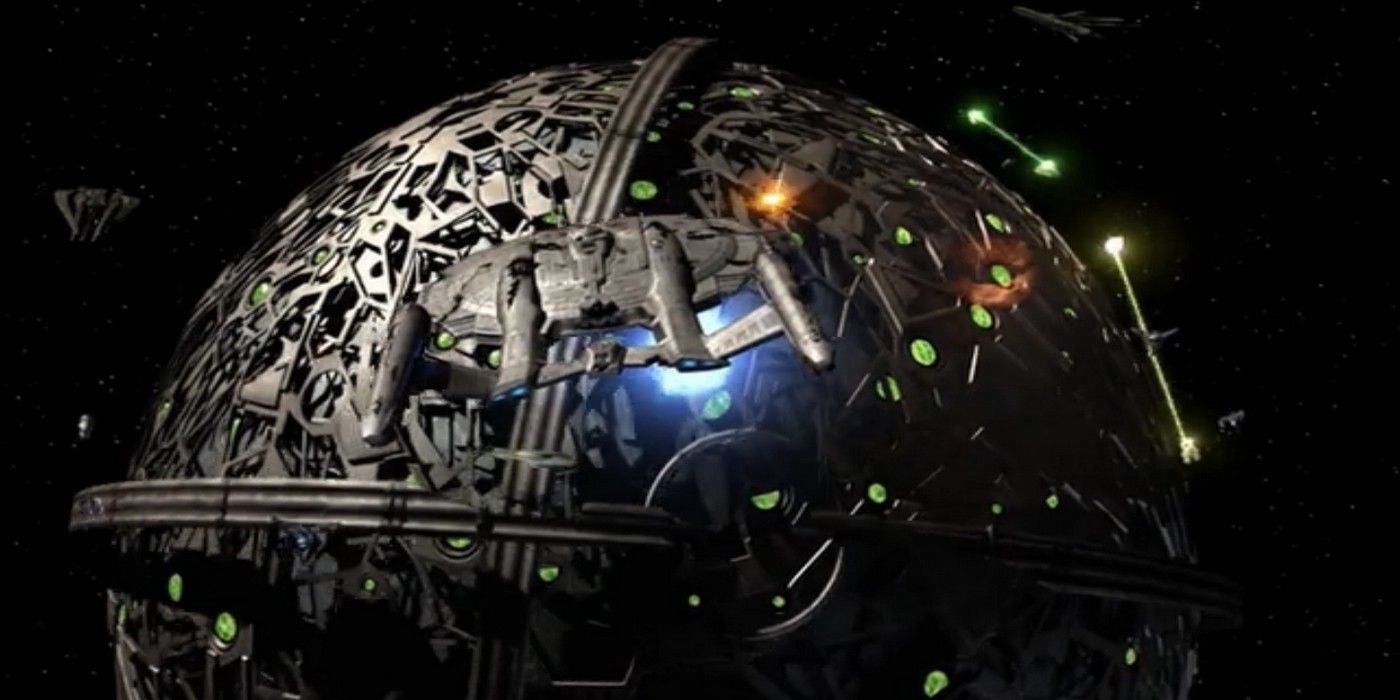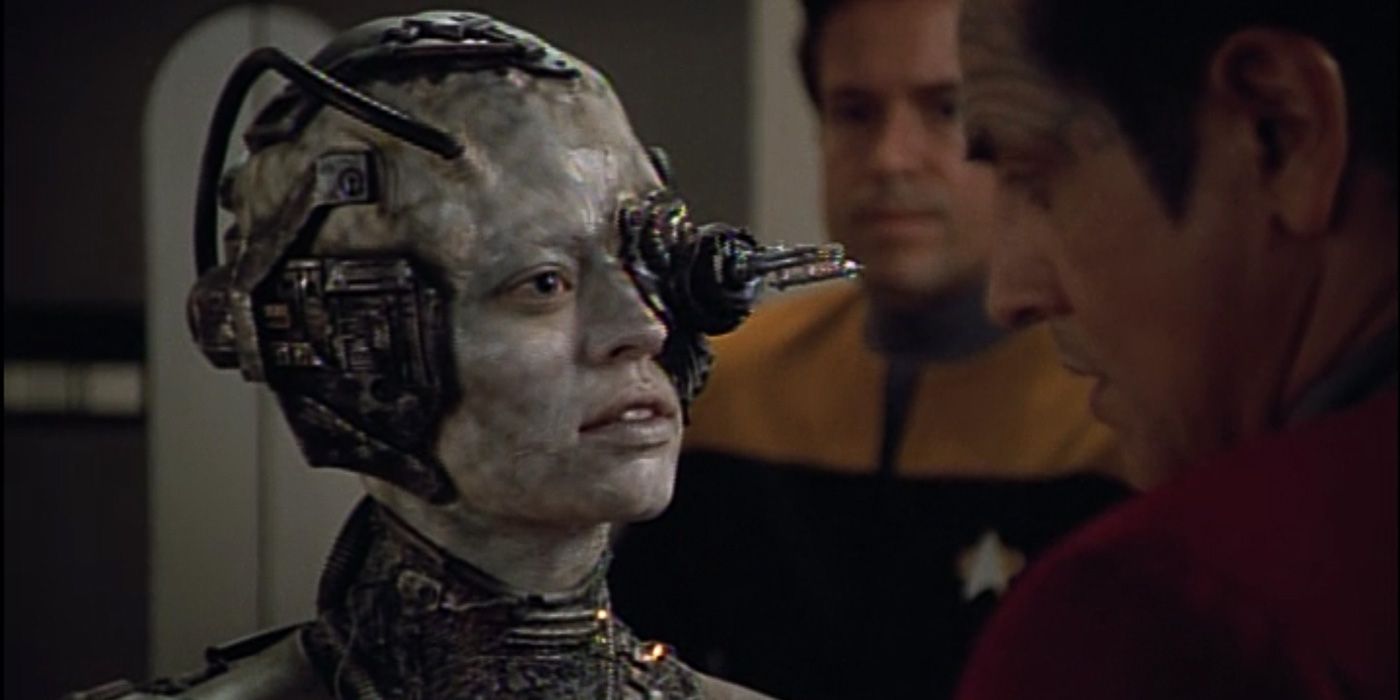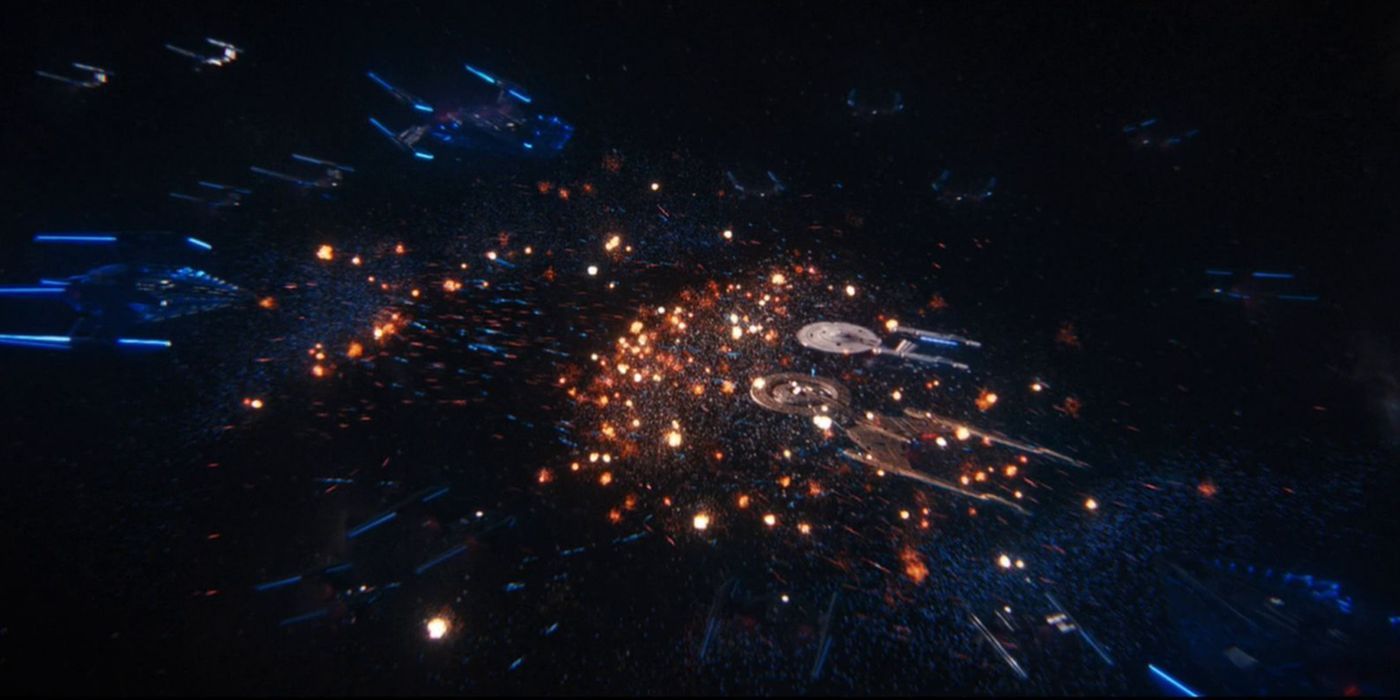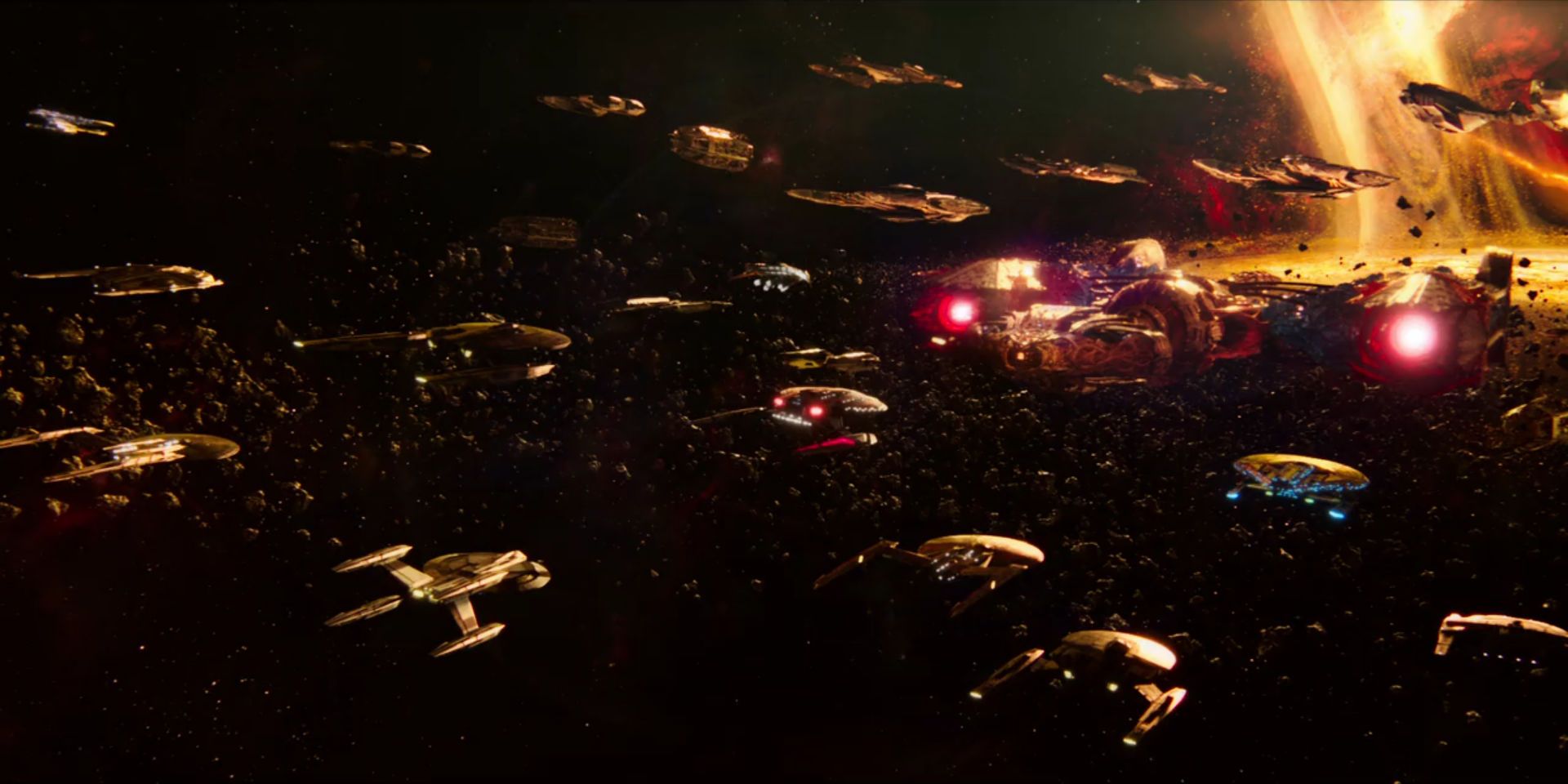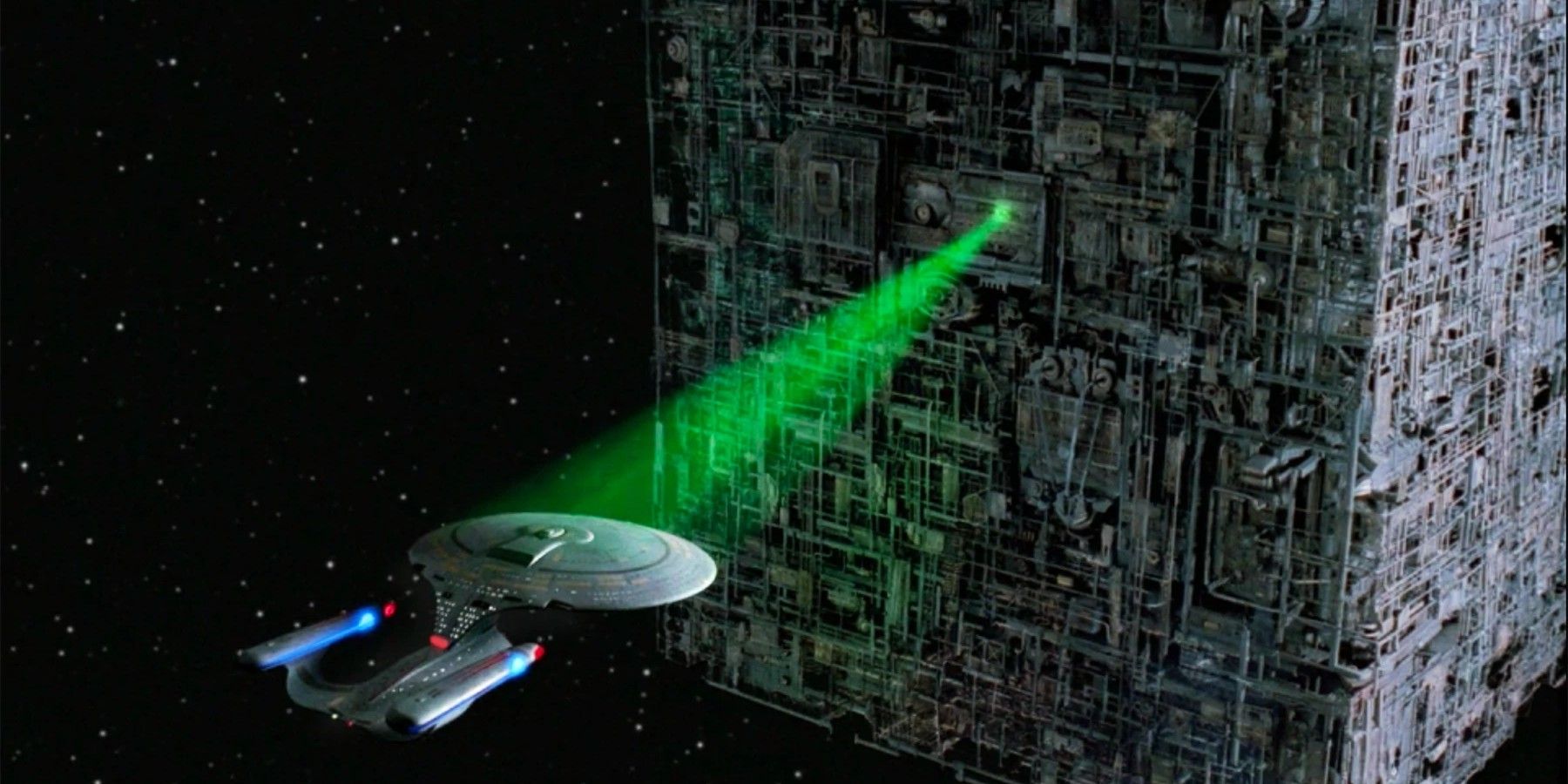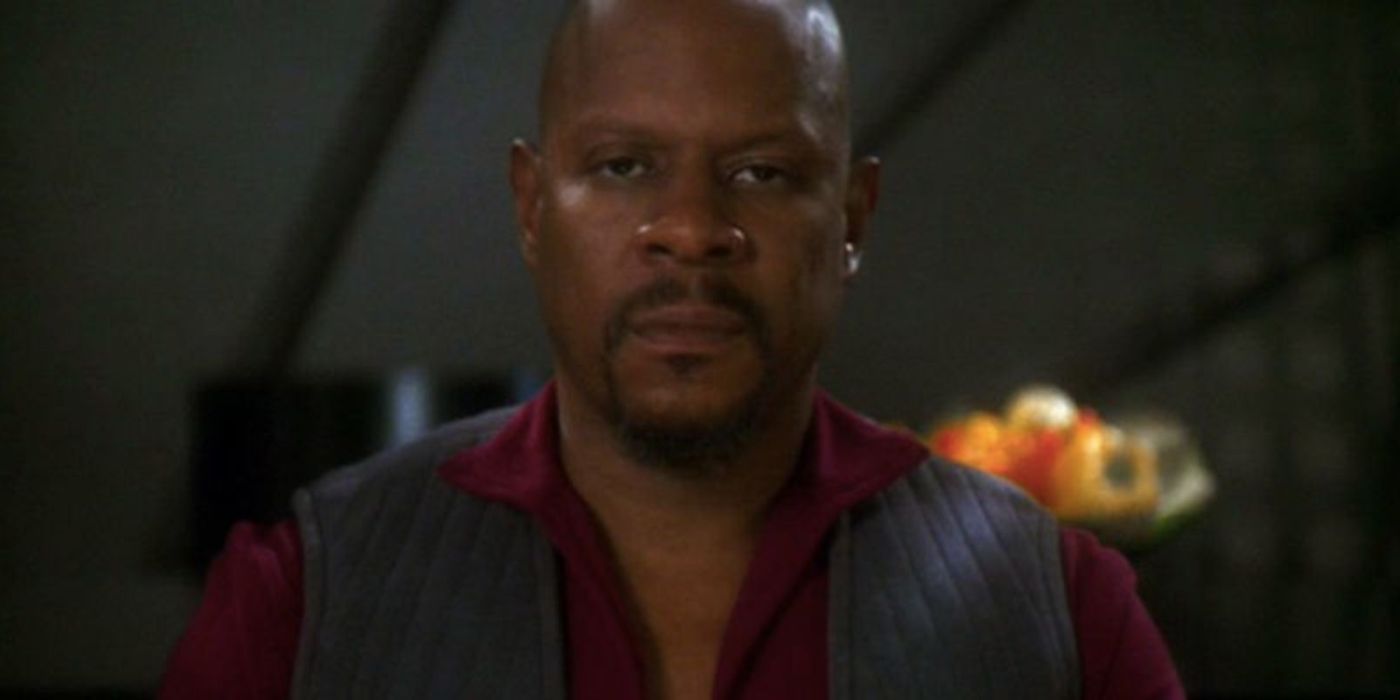Here are the greatest wars of Star Trek, which has actually had more wars across its franchise than Star Wars. At its core, Star Trek is about an optimistic future of space exploration and the harmonious co-existence of multiple worlds as embodied by the United Federation of Planets. And yet, Star Trek's history is full of conflict; indeed, after The Original Series in the 1960s, every Star Trek TV series has been embroiled in some form of war.
Predating Star Wars' creation by a decade, Star Trek's central tenet is about seeking out new worlds and new civilizations. But even though Captain Kirk (William Shatner) and the Starship Enterprise of the 23rd-century dealt with all manner of hostile alien lifeforms, actual full-blown wars weren't something depicted until Star Trek: The Next Generation's 24th-century era. By contrast, George Lucas' creation was titled Star Wars but the films really only dealt with three wars: The Clone Wars of the prequels, the conflict between the Empire and the Rebellion in the original trilogy, and the First Order vs. the Resistance in the sequel trilogy. Meanwhile, the five Star Trek spinoff TV series have involved several wars across the various eras of the Federation.
Indeed, the history of Star Trek was forged through wars: the Eugenics Wars of the 1990s gave rise to the villainous Khan and World War III in the 21st-century devastated humanity before First Contact with the Vulcans opened the door to the establishment of Starfleet. The United Federation of Planets was then founded in 2161, which Star Trek: Enterprise's Captain Jonathan Archer (Scott Bakula) presided over. But prior to the Federation's formation, the Earth-Romulan War of 2156-2160 led to the creation of the Romulan Neutral Zone and Star Trek: Discovery's Klingon War of 2257 was an outbreak of open hostilities in the middle of a Cold War that lasted over 70 years, which finally ended when the Klingons sued for peace in 2293, as seen in Star Trek VI: The Undiscovered Country.
While the Star Trek movies set in the Prime and Kelvin timelines had their share of violent conflicts, the greatest wars of Star Trek were depicted across the various TV series from Star Trek: The Next Generation to Star Trek: Discovery. Here are the epic Star Trek wars that cumulatively outnumber those of Star Wars.
The Xindi War on Star Trek: Enterprise
Star Trek: Enterprise season 3 saw the crew of the NX-01 Enterprise caught up in a year-long war with the Xindi, which was just part of a larger Temporal Cold War fought across the timestream by different factions. In the Star Trek: Enterprise season 2 finale, the Xindi attacked Earth with a superweapon, which devastated a swath of Earth from Florida to Venezuela and killed seven million people.
Captain Archer led an upgraded Enterprise into the Delphic Expanse to stop the Xindi from launching a second attack; during the course of the war, Archer learned the Xindi were pawns of another race called the Sphere-Builders, who were capable of seeing alternate timelines. The Sphere-Builders were trying to destroy Earth in the 22nd century, fearing a future where the Federation would destroy the Sphere-Builders in the 26th century. Eventually, Archer made peace with the Xindi and convinced them that they were being manipulated by the Sphere-Builders; the Enterprise crew destroyed the Xindi primary weapon before it could attack Earth again and they destroyed the Spheres, banishing the Builders back to their native trans-dimensional realm.
The Borg Vs. Species 8472 on Star Trek: Voyager
In 2374, as the U.S.S. Voyager entered Borg space in the Delta Quadrant, they were caught in the middle of the war between the Borg and Species 8472. The two deadly races battled for over 5 months, with the Borg suffering heavy casualties as they encountered the first alien species they could not easily assimilate or defeat. Species 8472 was a highly-advanced biological race that existed in fluidic space. When the Borg discovered a way to access fluidic space, they tried and failed to conquer Species 8472, who then went on the offensive and invaded the Milky Way galaxy. One bio-ship from Species 8472 could destroy 15 Borg Cubes and in one encounter, Species 8472 destroyed 8 Borg planets, 312 ships, and killed 4,000,621 drones.
Fearing this new threat, Captain Kathryn Janeway (Kate Mulgrew) partnered with the Borg, which brought Seven of Nine (Jeri Ryan) aboard the U.S.S. Voyager. The Starfleet/Borg alliance developed a biological weapon that forced Species 8472 back to fluidic space, ending the war. Later, Species 8472 determined that humanity was a greater threat than the Borg and created simulations in order to defeat the Federation and human beings. However, Janeway brokered peace with Species 8472, convincing them that the Federation had no designs on invading fluidic space.
The War Against Control on Star Trek: Discovery Season 2
In Star Trek: Discovery season 2, Control, Section 31's threat assessment system, attempted to gain sentience and wipe out all biological life in the galaxy - a goal Control achieved by the 32nd century according to the time-traveling Red Angel, who was revealed to be Dr. Gabrielle Burnham (Sonja Sohn). Much of Star Trek: Discovery season 2 centered on the U.S.S. Discovery's pursuit of the secret of the red signals in space, which ended up providing the means to stop Control. This included freeing Kaminar, the Kelpien homeworld, from dominion by the Ba'ul and Captain Christopher Pike (Anson Mount) acquiring a Klingon time crystal.
It all culminated in the final battle against Control in Star Trek: Discovery's season 2 finale, "Such Sweet Sorrow", where the U.S.S. Discovery and the U.S.S. Enterprise were joined by the Kelpiens and the Klingons to battle Section 31's drone fleet. The climactic battle was the most eye-popping and violent space battle ever depicted in a Star Trek TV series and it ended with the destruction of Control as Michael Burnham (Sonequa Martin-Green) assumed the identity of the Red Angel and led the Starship Discovery into the 32nd century to prevent Control from ever gaining sentience.
Star Trek: Discovery Season 1's Klingon War
The Klingon War against the Federation of 2256-2257 spanned the entirety of Star Trek: Discovery season 1. The war was started by Commander Michael Burnham at the Battle at the Binary Stars, which left her disgraced and imprisoned as Starfleet's first mutineer. Meanwhile, the Klingon Messiah T'Kuvma (Chris Obi) tried to unite all of the Great Houses under his leadership but after Burnham killed him, the warrior race splintered off into opposing factions while continuing the war against the Federation.
The Federation suffered devastating losses during the Klingon War: over 8,000 Starfleet personnel died in the first 6 months of the conflict. Nine months later, twenty percent of Federation space was occupied by the Klingons, including Starfleet's Starbase 1, which saw 80,000 lives lost. When the U.S.S. Discovery returned from its diversion into the Mirror Universe, the Terran Emperor Phillipa Georgiou, posing as her counterpart Captain Philippa Georgiou, attempted to commit genocide on the Klingon homeworld in a bid to end the war before the Klingons could invade Earth. In response, Michael Burnham allied with L'Rell (Mary Elizabeth Chieffo) to stop Georgiou's plan; they installed L'Rell as the new Klingon High Chancellor and ended the war.
The Federation Vs. The Borg on Star Trek: The Next Generation
The Federation's conflict with the Borg was mostly fought in Star Trek: The Next Generation and the subsequent feature film Star Trek: First Contact. In the classic two-part episode "The Best of Both Worlds", the Borg Collective mounted their invasion of the Federation, assimilating Captain Jean-Luc Picard (Patrick Stewart) and turning him into Locutus of Borg. It culminated in the Battle of Wolf 359, one of the most destructive engagements of the 24th century: 39 Starfleet ships were lost against one Borg Cube, with over 11,000 people either killed or assimilated. Though the U.S.S. Enterprise-D rescued Picard and destroyed the Borg Cube, it wouldn't be their last encounter with the Borg.
The Battle of Wolf 359 had lasting repercussions: the Defiant-class starships were developed to fight the Borg and Commander Benjamin Sisko (Avery Brooks) lost his wife Jennifer in the conflict. The Borg later attempted to time travel and assimilate 22nd century Earth in Star Trek: First Contact but Picard and his crew foiled them again. However, the Federation never completely defeated the Borg, who will return in Star Trek: Picard, although a faction of the Borg Collective has seemingly been conquered by the Romulans. Still, the Borg remain a hostile threat to the Federation any time they emerge from their home base in the Delta Quadrant.
The Dominion War on Star Trek: Deep Space Nine
The Dominion War in Star Trek: Deep Space Nine is the greatest war ever fought in Star Trek. At its peak, the conflict involved every major power in the Alpha Quadrant siding with two opposing factions: the Federation, Klingons, and Romulans vs. the Dominion, Cardassian, and Breen alliance. While the formal hostilities lasted from 2373-2375, the Dominion instigated a Federation-Klingon War, destroyed the Cardassian Obsidian Order and the Romulan Tal'Shiar, and successfully executed a coup on Cardassia prior to the Dominion War, which weakened the Alpha Quadrant before the Changelings and the Jem'Hadar mounted their full-scale invasion from the Gamma Quadrant.
The devastation caused by the Dominion War was staggering: thousands of starships and millions of lives were lost on both sides, with Cardassia suffering the most as the Dominion systematically eliminated the Cardassian population, killing 800 million civilians in the waning days of the war. The Dominion also conquered Betazed, homeworld of Counselor Deanna Troi (Marina Sirtis), and the Breen attacked Starfleet Headquarters on Earth. Captain Sisko tricking the Romulans to fight on the Federation's side turned the tide of the war, while Section 31's use of a biogenic virus by secretly causing Odo to infect the Founders accelerated the Federation's ultimate victory. Sisko led the invasion of Cardassia that resulted in the signing of the Treaty of Bajor on Deep Space Nine, formally ending the war and forcing the Dominion to permanently retreat into the Gamma Quadrant.
The Dominion War altered the balance of power in the Alpha Quadrant; the Klingons incurred such loses that it would take them a decade to recover and the Cardassian Union completely collapsed, which left the Federation and Romulans as the strongest powers in the Quadrant - until Shinzon's coup wiped out the Romulan Senate in Star Trek: Nemesis. Thanks to the serialized format of Star Trek: Deep Space Nine, which boasted 26 episodes per season, the series was able to depict the myriad complexities of the Dominion War from the military, political, and characters' perspectives. All in all, Star Trek fans may not see a war as epic and far-reaching as the Dominion War again.

